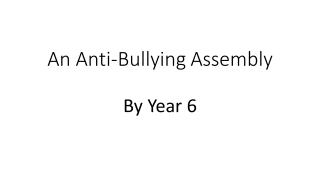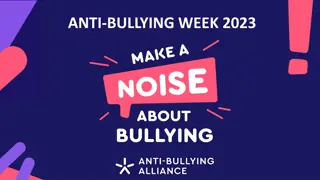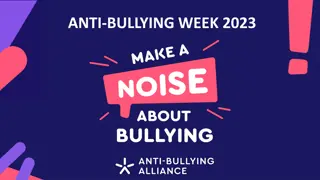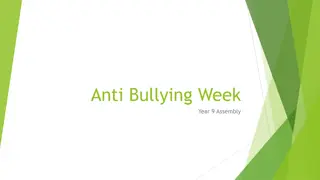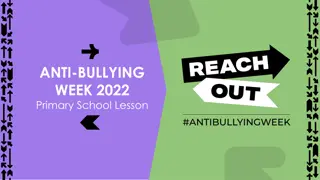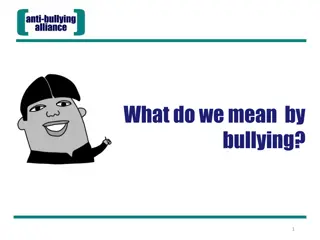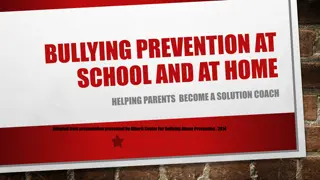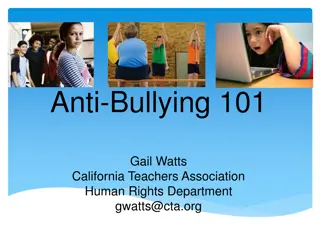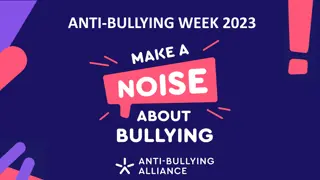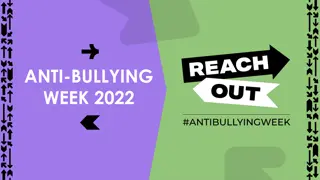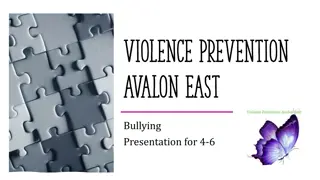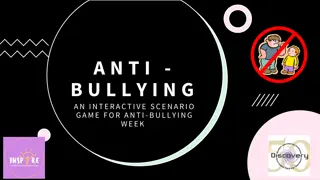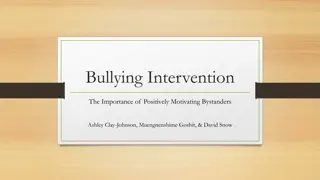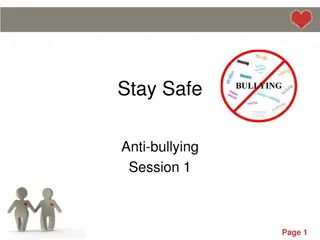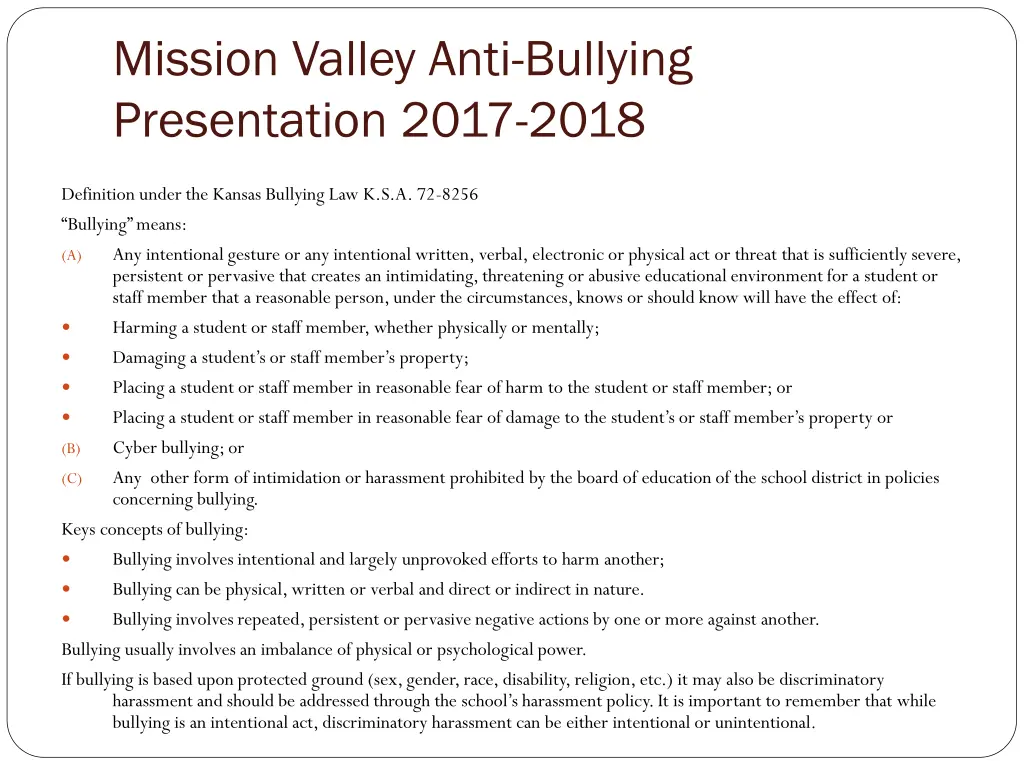
Understanding Bullying: Definitions, Characteristics, and Factors
Explore the definition of bullying under Kansas law, delve into the characteristics of bullies, and understand the various factors contributing to bullying behavior. Gain insights into intentional acts that create an intimidating or abusive environment, traits of bullies, and societal influences on bullying.
Download Presentation

Please find below an Image/Link to download the presentation.
The content on the website is provided AS IS for your information and personal use only. It may not be sold, licensed, or shared on other websites without obtaining consent from the author. If you encounter any issues during the download, it is possible that the publisher has removed the file from their server.
You are allowed to download the files provided on this website for personal or commercial use, subject to the condition that they are used lawfully. All files are the property of their respective owners.
The content on the website is provided AS IS for your information and personal use only. It may not be sold, licensed, or shared on other websites without obtaining consent from the author.
E N D
Presentation Transcript
Mission Valley Anti-Bullying Presentation 2017-2018 Definition under the Kansas Bullying Law K.S.A. 72-8256 Bullying means: Any intentional gesture or any intentional written, verbal, electronic or physical act or threat that is sufficiently severe, persistent or pervasive that creates an intimidating, threatening or abusive educational environment for a student or staff member that a reasonable person, under the circumstances, knows or should know will have the effect of: Harming a student or staff member, whether physically or mentally; Damaging a student s or staff member s property; Placing a student or staff member in reasonable fear of harm to the student or staff member; or Placing a student or staff member in reasonable fear of damage to the student s or staff member s property or Cyber bullying; or Any other form of intimidation or harassment prohibited by the board of education of the school district in policies concerning bullying. Keys concepts of bullying: Bullying involves intentional and largely unprovoked efforts to harm another; Bullying can be physical, written or verbal and direct or indirect in nature. Bullying involves repeated, persistent or pervasive negative actions by one or more against another. Bullying usually involves an imbalance of physical or psychological power. If bullying is based upon protected ground (sex, gender, race, disability, religion, etc.) it may also be discriminatory harassment and should be addressed through the school s harassment policy. It is important to remember that while bullying is an intentional act, discriminatory harassment can be either intentional or unintentional. (A) (B) (C)
Characteristics of Bullies Behavior of bullies is seldom severe enough to lead automatically to peer rejection or academic failure. Three psychological advantages that allow kids to harm others: A sense of entitlement An intolerance toward differences and; A liberty to exclude Bullying is arrogance in action. Characteristics: a. Has a role model b. Likes bullying and finds it exciting c. Has positive view of aggression d. Is excited by the victim s reaction e. Enjoys being in control and dominating others Does Not feel empathy for the victim Is concerned only with his/her own wants and pleasures, not needs, rights of feelings of others Rationalizes his/her behavior Uses blame, criticism and false allegations to project his/her own inadequacies onto the target Refuses to accept responsibility for his/her actions Seek attention Equates fear with respect Has a low threshold for frustration 1. 2. 3. f. g. h. i. j. k. l. m.
Factors Contributing to Bullying Substance abuse Poor academic achievement Mental health problems Family violence Poor parenting skills to harsh or to permissive Societal factors, bigotry, alcohol or drugs, seeing bullying as an inevitable consequence of a society that rewards perceived strength and dominance. School factors, supervision, schools attitude towards bullying and school performance also influences bullying behavior. The media, 44% of the violent interaction on TV involves perpetrators who have some attractive qualities, 66% of TV programs contain some violence; only 4 percent of these feature an anti-violent theme, nearly 75% of violent scenes on TV feature no immediate punishment for or condemnation of violence.
Who Gets Bullied 80 to 85 percent of targets are passive victims who do nothing directly provoke bullies. 15 to 20 percent of victims are provocative victims who behave in ways that provoke negative responses from those around them. Bullies look for students who reward them by showing distress, relinquishing tangible resources and are less likely to retaliate or report. Passive victims characteristics a. Poor self-esteem b. Often loners, isolated, socially withdrawn c. Often lack self-esteem and social skills d. Can t use humor to deflect bullying e. Often social outcasts, often picked last for games Provocative victims a. Restlessness b. Off task behaviors c. Hostility d. Emotionally aroused e. Sometimes tease and bully themselves
Types of Bulling Physical-Accounts for less than one-third of the reported incidents. Verbal most common form of bullying used by girls and boys both. It is easy for students to get away with and is often times overlooked. Adults many times tend to look at bullying as normal peer conflict assuming students will grow out of it or work it out. Adults tend to use phrases like, stand up for yourself , ignore it, I am sure they didn t mean to hurt you, , or just don t let it bother you, . Children that engage in bullying behavior do intend to hurt someone. Children are bullied because bullies choose to attack them and no one intervenes on their behalf. Relational Aggression includes, manipulating relationships with peers, spreading rumors, withholding friendships, ignoring, ostracizing, directing others not to associate, giving the silent treatment and gossiping. Studies indicate girls are more likely than boys to be relationally aggressive with other girls or be provoked by relational aggression. Cyberbullying, Kansas law defines cyberbullying as bullying by use of any electronic communication device through means including, but not limited to, email, instant messages, blogs, mobile phones, pagers, online games and websites . K.S.A. 72-8256. Types of cyberbullying: Flaming, online fights using electronic messages with angry and vulgar messages Denigration, dissing someone online; polls; posting gossip or rumors to ruin reputation or friendships Impersonation, pretending to be someone else to get them in trouble or to damage their reputation or friendship. Harassment, repeatedly sending nasty, mean and insulting messages Outing, sharing someone s secrets, embarrassing information or images online Trickery, tricking someone into sharing embarrassing information, then sharing it online Exclusion, intentionally and cruelly excluding someone from an online group Cyberstalking, repeated, intense harassement and denigration that includes threats or creates significant fear Cyberbullying differs significantly from school yard bullying, The bully can often remain anonymous Bullying can occur 24/7 and victims can be humiliated in a worldwide venue. Students are reluctant to tell adults for fear their computer privileges will be revoked. a. b. c. d. e. f. g. h. 1. 2. 3.
Types of bullying continued Sexual or Homophobic Bullying-75% of gay teenagers report being bullied. This type of bullying often constitutes harassment on the basis of sex or gender. Sexting, sending sexually explicit pictures to others, through cell phones or other electronic means. When these pictures involve minors, child pornography laws maybe implicated and school searches of cell phones are not advised.
Effects of Bullying Bullying has an effect on all players in a bullying situation-the bully, the target and the bystanders Studies show that primary age children who were labeled by their peers as bullies: 1. Require more support as adults for government agencies 2. Have more court convictions 3. Suffer more alcoholism 4. Use ore mental health services than their peers who do not engage in bullying behavior. An eight year old bully is six times more likely to be convicted of a crime by age 24 and five times more likely to be convicted of a serious crime by age 30 than a nonbully. Effects on targets, estimates are that 160,000 students miss school for fear of being bullied. 10% of kids that drop out of school do so because of bullying. Suicide rates for adolescents have tripled in the past 20 years and it is estimated that one in five victims of bullying contemplate suicide. 71% of school attackers felt bullied, persecuted, threatened, attacked or injured by others prior to the attack. School Shooters, 51 % were honor students, only 5 % were failing, 41% were considered normal mainstream students until the attacks, 34% were considered loners. 44% were involved in school or outside organized activities. Only 10% had ever been suspended from school. 66% were never in trouble at school. 81% of the time someone else knew about the attack before it occurred.
Effects on Bystanders Bystanders to bullying incidents may experience the following: 1. Fear of associating with the victim 2. Lower status 3. Retribution from bullying 4. Fear reporting the bully 5. Feelings of guilt and helplessness for not standing up to the bully Bystanders are drawn into bullying by group peer pressure. They feel unsafe, unable to take action and as if they have lost of control. Unfortunately, this loss of sense of security reduces learning capacity. Tattling and reporting, tattling is when a child tells on another student to get them in trouble. Reporting is when a student tells an adult what another student did because that student s actions were unsafe or hurt another person. There is a fine line between tattling and reporting.
Where Bullying Occurs Number one location for bullying areas of little or no supervision. Supervision reduces the amount of bullying in a school. Locations of bullying in order of frequency: 1. Playground or athletic fields 2. Hallways 3. Lunchroom 4. Classroom without teacher 5. Classroom with teacher 6. Somewhere else 7. On the bus 8. PE or Locker room 9. Bathroom 10. On route to and from school 11. Bus Stop. Major deterrent to bullying is good supervision.
Responding to Bullying 69 percent of students said schools do not respond effectively to bullying. In one study only 25 percent of students reported that teachers intervene in bullying situations, while 71 percent of the teachers believe they always intervene. Another study suggested that on the playground, adults intervene only 4% of bullying incidents. Data gathered by the Olweus Institute on adult or student intervention suggests younger students are more likely than older students to perceive either adults or fellow students intervene in bullying incidents. Third through fifth graders of both sexes believe adults intervene close to half the time but other students intervene less than one-quarter of the time. By high school, students believe that adults intervene in one of three incidents, while students intervene less than one out of 10 times when they witness bullying. These statics indicate a higher than previously reported number of incidents and it is believed that it is a result of increased awareness of bullying problems has promoted intervention.
Preventing Bullying Olweus Institute suggests the following action to help create a safe environment in which students and employees can work and learn free from bullying: 1. Assess the awareness and the scope of the bullying problem at your school. 2. Put strategies in place to make these locations where bullying occurs less attractive to bullies. 3. Conduct school wide-assemblies and teacher/staff in-service training to raise awareness regarding the problem of bullying and to communicate a zero tolerance for such behavior. 4. Establish clear behavior standards, including rules against bullying, publicize the standards and consistently and fairly enforce such standards. 5. Be familiar with your schools policy and complaint procedures for bullying and discriminatory harassment. Make their procedures known to parents and students. 6. Model desired attitudes and behaviors treating all students and staff with respect. 7. Help students to play an active role in intervening in bullying and give them strategies for helping themselves and others 8. Reward student s for good performance and behavior 9. Encourage parent participation. 10. Receive and listen receptively to parent who report bullying.
Preventing Bullying 11. Establish a confidential reporting system that allows children to report victimization and that records the details of bullying incidents. 12. Investigate and resolve reports of bullying expeditiously at the school level in order to avoid perpetuating bullying. 13. Develop strategies to reward students for positive, inclusive behavior 14. Provide school wide and classroom activities that are designed to build self-esteem and that foster mutual understanding of appreciation for differences in others. 15. Provide supports for targets of bullying and protect from retaliation.
Mission Valley School District Anti- Bullying Policy JDDC Bullying (See GAAB, JCE, JGEC, JGECA, JDD and EBC) The Mission Valley School district prohibits bullying in any form on school property, in school vehicles or at school sponsored activities or events. The administration shall propose and the board shall review and approve a plan to address bullying on school property, in a school vehicle or at a school sponsored activity or event. The plan shall include provisions for training and education of staff members and students and shall include appropriate community involvement as approved by the board. Students who have bullied others in violation of this policy may be subject to disciplinary action, up to and including suspension and expulsion. If appropriate, students who violate the bullying prohibition shall be reported to local law enforcement. Approved: KASB Recommendation-06/07 As used in this policy, the following definitions apply. Bullying means: (A) Any intentional gesture or intentional written, verbal, electronic or physical act or threat that is sufficiently severe, persistent or pervasive that it creates an intimidating, threatening or abusive educational environment for a student or staff member that reasonable person, under the circumstances, knows or should know will have the effect of: Harming a student or staff member, whether physically or mentally; Damaging a student s or staff member property; Placing a student or staff member in reasonable fear of harm to the student or staff member; or Placing a student or staff member in reasonable fear of damage to the student s or staff member s property; or (B) Cyberbullying, or (C) any other form of intimidation or harassment prohibited by any policy of USD 330 (2) Cyberbullying means bullying by use of any electronic communication device through means including, but not limited to, email, instant messaging, text messaging, blogs, mobile phones, pagers, online games and websites. (3) School vehicle means any school bus, school van, other school vehicle and private vehicle used to transport students or staff members to and from school or any school-sponsored activity or event.
Informal Complaint Form Informal Complaint Form Students, or staff that wish to make an informal complaint are to report to the building administrator. The building administrator will complete an informal complaint form on all bullying complaints as well as investigate the complaint. If the bullying incident warrants a formal complaint the staff member or student may file a formal complaint form. The building administrator may also file a formal complaint. Any student with a history of bullying incidents may have a formal complaint files against them. Disciplinary action will be determined by the building administrator. All informal complaints will be kept on file. Mission Valley School District Bullying Reporting form This report is to be completed for each reported incidents of bullying. This is not a formal compliant sheet. Students wanting to make a formal report will need to complete a formal compliant sheet. This will be kept as a record to support any repetitive bullying behaviors. Name of person being reported______________________________ Date of Incident ____________________________ Time of Incident___________ Place of Incident: Hallway, Restroom, Bus, Lunchroom, Gym, Playground, Classroom, Other. Description of incident: ____________________________________________________ __________________________________________________________________________________________________________________________ __________________________________________________________________________________________________________________________ ________________________________________________ Names of other students who also saw the incident occur: _____________________________________ __________________________________ _____________________________________ _________________________________ _____________________________________ __________________________________ Name of person filing out the report_________________________________________ Action taken: _____________________________________________________________ __________________________________________________________________________________________________________________________ __________________________________________________________________________________________________________________________ ________________________________________________ Signed___________________________________________
Formal Complaint forms can be filed by students, staff or parents. All formal complaints will be investigated and punishment will be determined by the building administrator. All formal complaints are kept on file. Date of Incident: __________________________ Time of Incident: _________________________ Location of the Incident: Classroom, Bus, Hallway, Gym, locker room, playground, lunch room, shop, weight room. Complainant__________________________________________________________________ ________________________________________________________________________________________________________ ____________________________________________________ Name of person (s) you believe bullies you___________________________________________ ______________________________________________________________________________ Name of Witnesses ____________________________, ________________________________ ______________________________, ______________________________,________________ ______________________________,_______________________________,________________ Describe the incident or incidents as clearly as possible, including such things as: what force, if any, was used any verbal statements (threats, requests or demands, etc.) what if any physical contact was involved. What acts have taken place previously? ________________________________________________________________________________________________________ ________________________________________________________________________________________________________ ________________________________________________________________________________________________________ ________________________________________________________________________________________________________ ________________________________________________________________________________________________________ ________________________________________________________________________________________________________ Signature_______________________________________________________ Date: __________

